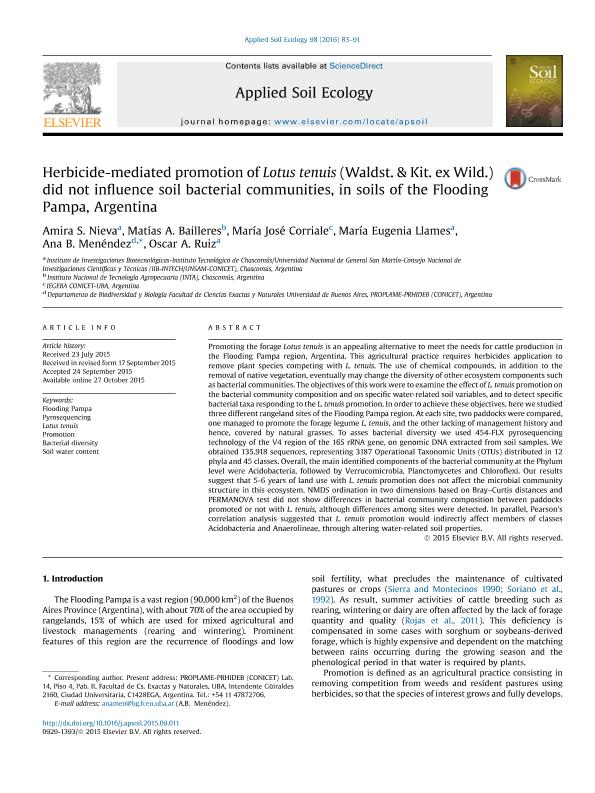Artículo
Herbicide-mediated promotion of Lotus tenuis (Waldst. & Kit. ex Wild.) did not influence soil bacterial communities, in soils of the Flooding Pampa, Argentina
Nieva, Amira Susana del Valle ; Bailleres, Matías Andres; Corriale, Maria Jose
; Bailleres, Matías Andres; Corriale, Maria Jose ; Llames, Maria Eugenia del Rosario
; Llames, Maria Eugenia del Rosario ; Menendez, Ana Bernardina
; Menendez, Ana Bernardina ; Ruiz, Oscar Adolfo
; Ruiz, Oscar Adolfo
 ; Bailleres, Matías Andres; Corriale, Maria Jose
; Bailleres, Matías Andres; Corriale, Maria Jose ; Llames, Maria Eugenia del Rosario
; Llames, Maria Eugenia del Rosario ; Menendez, Ana Bernardina
; Menendez, Ana Bernardina ; Ruiz, Oscar Adolfo
; Ruiz, Oscar Adolfo
Fecha de publicación:
02/2016
Editorial:
Elsevier Science
Revista:
Applied Soil Ecology
ISSN:
0929-1393
Idioma:
Inglés
Tipo de recurso:
Artículo publicado
Clasificación temática:
Resumen
Promoting the forage Lotus tenuis is an appealing alternative to meet the needs for cattle production in the Flooding Pampa region, Argentina. This agricultural practice requires herbicides application to remove plant species competing with L. tenuis. The use of chemical compounds, in addition to the removal of native vegetation, eventually may change the diversity of other ecosystem components such as bacterial communities. The objectives of this work were to examine the effect of L. tenuis promotion on the bacterial community composition and on specific water-related soil variables, and to detect specific bacterial taxa responding to the L. tenuis promotion. In order to achieve these objectives, here we studied three different rangeland sites of the Flooding Pampa region. At each site, two paddocks were compared, one managed to promote the forage legume L. tenuis, and the other lacking of management history and hence, covered by natural grasses. To asses bacterial diversity we used 454-FLX pyrosequencing technology of the V4 region of the 16S rRNA gene, on genomic DNA extracted from soil samples. We obtained 135.918 sequences, representing 3187 Operational Taxonomic Units (OTUs) distributed in 12 phyla and 45 classes. Overall, the main identified components of the bacterial community at the Phylum level were Acidobacteria, followed by Verrucomicrobia, Planctomycetes and Chloroflexi. Our results suggest that 5-6 years of land use with L. tenuis promotion does not affect the microbial community structure in this ecosystem. NMDS ordination in two dimensions based on Bray?Curtis distances and PERMANOVA test did not show differences in bacterial community composition between paddocks promoted or not with L. tenuis, although differences among sites were detected. In parallel, Pearson?s correlation analysis suggested that L. tenuis promotion would indirectly affect members of classes Acidobacteria and Anaerolineae, through altering water-related soil properties.
Archivos asociados
Licencia
Identificadores
Colecciones
Articulos(CCT - LA PLATA)
Articulos de CTRO.CIENTIFICO TECNOL.CONICET - LA PLATA
Articulos de CTRO.CIENTIFICO TECNOL.CONICET - LA PLATA
Articulos(IEGEBA)
Articulos de INSTITUTO DE ECOLOGIA, GENETICA Y EVOLUCION DE BS. AS
Articulos de INSTITUTO DE ECOLOGIA, GENETICA Y EVOLUCION DE BS. AS
Articulos(IIB-INTECH)
Articulos de INST.DE INVEST.BIOTECNOLOGICAS - INSTITUTO TECNOLOGICO CHASCOMUS
Articulos de INST.DE INVEST.BIOTECNOLOGICAS - INSTITUTO TECNOLOGICO CHASCOMUS
Articulos(SEDE CENTRAL)
Articulos de SEDE CENTRAL
Articulos de SEDE CENTRAL
Citación
Nieva, Amira Susana del Valle; Bailleres, Matías Andres; Corriale, Maria Jose; Llames, Maria Eugenia del Rosario; Menendez, Ana Bernardina; et al.; Herbicide-mediated promotion of Lotus tenuis (Waldst. & Kit. ex Wild.) did not influence soil bacterial communities, in soils of the Flooding Pampa, Argentina; Elsevier Science; Applied Soil Ecology; 98; 2-2016; 83-91
Compartir
Altmétricas



